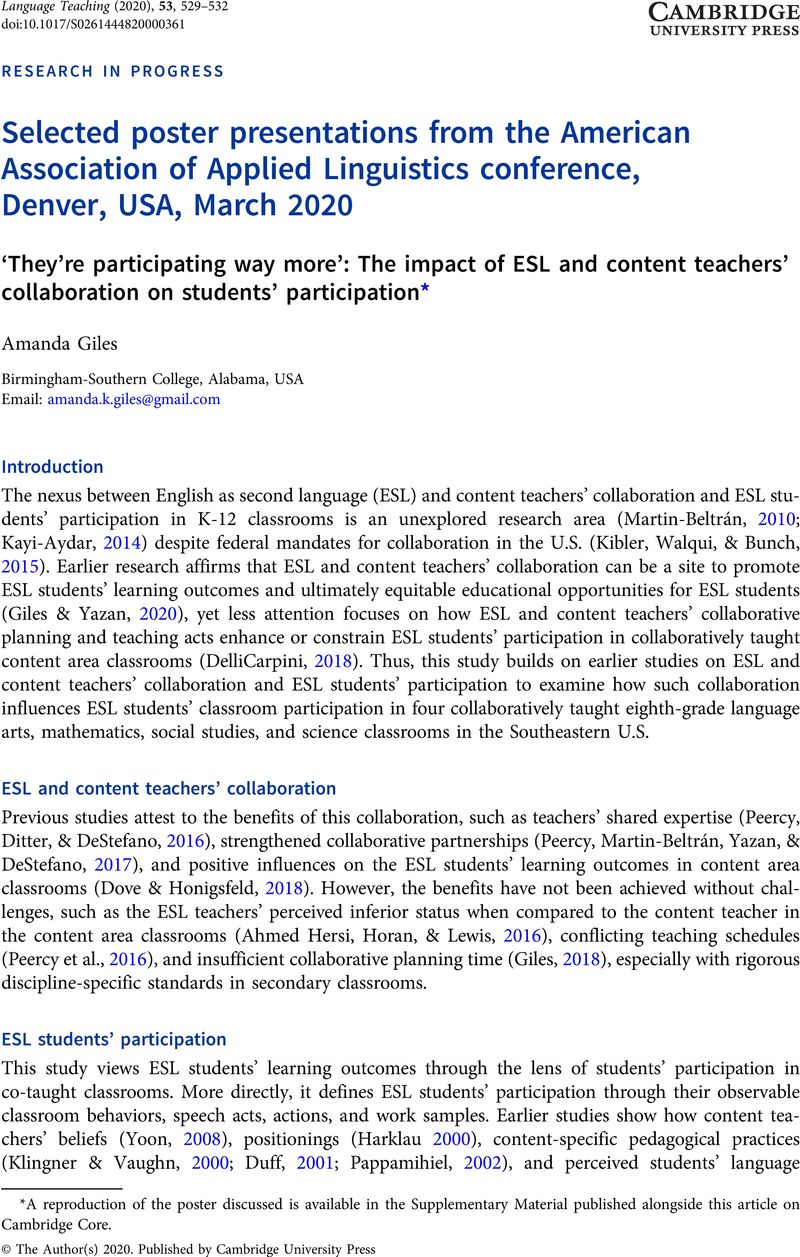No CrossRef data available.
Article contents
Selected poster presentations from the American Association of Applied Linguistics conference, Denver, USA, March 2020
‘They're participating way more’: The impact of ESL and content teachers’ collaboration on students’ participation
Published online by Cambridge University Press: 03 August 2020
Abstract
An abstract is not available for this content so a preview has been provided. Please use the Get access link above for information on how to access this content.

- Type
- Research in Progress
- Information
- Copyright
- Copyright © The Author(s) 2020. Published by Cambridge University Press
References
Ahmed Hersi, A., Horan, D. A., & Lewis, M. A. (2016). Redefining ‘community’ through collaboration and co-teaching: A case study of an ESOL specialist, a literacy specialist, and a fifth- grade teacher. Teachers and Teaching, 22(8), 927–946.CrossRefGoogle Scholar
Charmaz, K. (2006). Constructing grounded theory: A practical guide to qualitative analysis. Thousand Oaks, CA: Sage.Google Scholar
DelliCarpini, M. (2018). Administrative issues in collaborative teaching. In Liontas, J., DelliCarpini, M., Park, G., & Salas, S. (Eds.), TESOL encyclopedia of English language teaching (pp. 1–9). Hoboken, NJ: Wiley.Google Scholar
Dove, M., & Honigsfeld, A. (2018). Co-teaching for English learners: A guide to collaborative planning, assessment, and reflection. Thousand Oaks, CA: Corwin.Google Scholar
Duff, P. (2001). Language, literacy, content, and (pop) culture: Challenges for ESL students in mainstream courses. Canadian Modern Language Review, 58(1), 103–132.CrossRefGoogle Scholar
Giles, A. (2018). Navigating the contradictions: An ESL teacher's professional self-development. TESL Canada Journal, 35(2), 104–127.Google Scholar
Giles, A. (2019). The influences of ESL and content teachers’ collaboration on teachers’ learning and ESL students’ participation: A case study of middle school mainstream classrooms. (Unpublished doctoral dissertation). The University of Alabama, Tuscaloosa.Google Scholar
Giles, A., & Yazan, B. (2020). ‘You're not an island’: A language arts teacher's changed perceptions in ESL and content teachers’ collaboration. Research in Middle Level Education Online, 43(3), 1–15.Google Scholar
Harklau, L. (2000). From the ’good kids’ to the ‘worst’: Representations of English language learners across educational settings. TESOL Quarterly, 34(1), 35–67.Google Scholar
Kayi-Aydar, H. (2014). Social positioning, participation, and second language learning: Talkative students in an academic ESL classroom. TESOL Quarterly, 48(4), 686–714.Google Scholar
Kibler, A. K., Walqui, A., & Bunch, G. C. (2015). Transformational opportunities: Language and literacy instruction for English language learners in the Common Core era in the United States. TESOL Journal, 6(1), 9–35.Google Scholar
Klingner, J. K., & Vaughn, S. (2000). The helping behaviors of fifth graders while using collaborative strategic reading during ESL content classes. TESOL Quarterly, 34(1), 69–98.Google Scholar
Martin-Beltrán, M. (2010). Positioning proficiency: How students and teachers (de)construct language proficiency at school. Linguistics and Education, 21(4), 257–281.CrossRefGoogle Scholar
Miller, J. M. (2000). Language use, identity, and social interaction: Migrant students in Australia. Research on Language and Social Interaction, 33(1), 69–100.CrossRefGoogle Scholar
Pappamihiel, N. E. (2002). English as a second language students and English language anxiety: Issues in the mainstream classroom. Research in the Teaching of English, 36, 327–355.Google Scholar
Peercy, M. M., Ditter, M., & DeStefano, M. (2016). ‘We need more consistency’: Negotiating the division of labor in ESOL–mainstream teacher collaboration. TESOL Journal, 8(1), 215–239.CrossRefGoogle Scholar
Peercy, M. M., Martin-Beltrán, M., Yazan, B., & DeStefano, M. (2017). “Jump in any time”: How teacher struggle with curricular reform generates opportunities for teacher learning. Action in Teacher Education, 39(2), 203–217.CrossRefGoogle Scholar
Saldaña, J. (2013). The coding manual for qualitative researchers. Thousand Oaks, CA: Sage.Google Scholar
Yoon, B. (2008). Uninvited guests: The influence of teachers’ roles and pedagogies on the positioning of English language learners in the regular classroom. American Educational Research Journal, 45(2), 495–522.Google Scholar





